Gamini’s vitality, versality revealed-By Uditha Devapriya
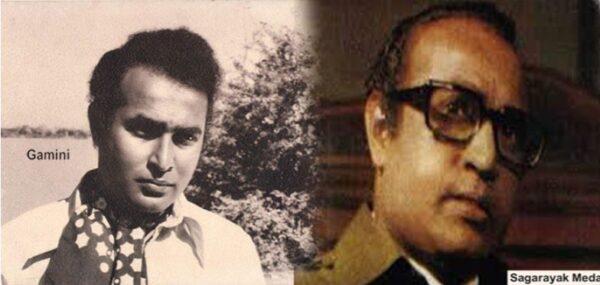
Source:Island
When he first makes an appearance in Gamperaliya, Gamini Fonseka has turned his back to us. As Jinadasa, the man who is to marry Nanda, his character remains faceless. Having gone through the usual, customary introductions, he and his family sit down with Nanda’s father, waiting for the woman he will wed not too long afterwards.
It is an arranged marriage, to be conducted on traditional Sinhala rites, but in keeping with those rites, the bride must first meet the groom. Yet even in the face of this first encounter, the husband-to-be-remains silent. We catch just one glimpse of him: his face hidden from us, his fingers tapping expectantly. Taking out a watch from his shirt pocket, he checks the time. He wants these formalities done with; he’s too impatient to wait.
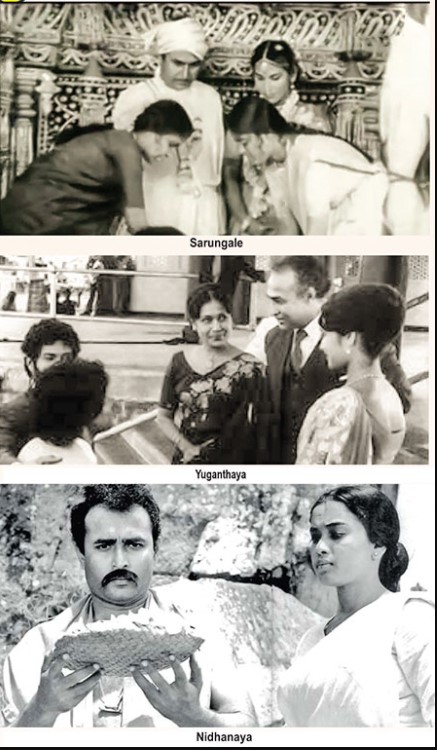 Then Nanda enters the room. Bearing some betel for the guests, she does what she’s called for and sits in a corner, her face looking down. The scene is extraordinary in its simplicity, in how it establishes the link between these people, the subtle interplay between conversation and silence, and the small talk that belies the tension of it all.
Then Nanda enters the room. Bearing some betel for the guests, she does what she’s called for and sits in a corner, her face looking down. The scene is extraordinary in its simplicity, in how it establishes the link between these people, the subtle interplay between conversation and silence, and the small talk that belies the tension of it all.
We still don’t see Jinadasa: we can catch a glimpse only when Nanda looks up. This Nanda does, and we behold him in full form: shy, hesitant, the faintest outline of a smile creeping up in a corner, he is as eager to see her as she is him. Yet Nanda’s eyes dart off, not to his face, but to his collar. Crushed and unkempt, it jars her. Jinadasa apologetically straightens it, but it does its trick: she accepts him, and they marry a few days later.
In this sequence, Lester James Peries establishes the intricacies of a Sinhala wedding. What distinguishes it, I think, is Punya Heendeniya’s performance: in keeping with the spirit of her character, she represses everything. Ediriweera Sarachchandra once described Nanda as a woman lacking agency. This Heendeniya embodies throughout.
In the scenes that follow, we see Nanda accept her husband for who he is, with the faintest hint of a bond between them. Like all traditional Sinhala women, from that period, she falls in line with the wishes of her elders. There is thus not a hint of the love that would ordinarily pass between husband and wife. But the devotion of the one to the other comes out rather powerfully. This is hardly a love marriage, yet in her performance Heendeniya underscores the poignancy of her love. Later, when she breaks down after hearing news of her husband’s death, we will realise the complexity of her attachment to him.
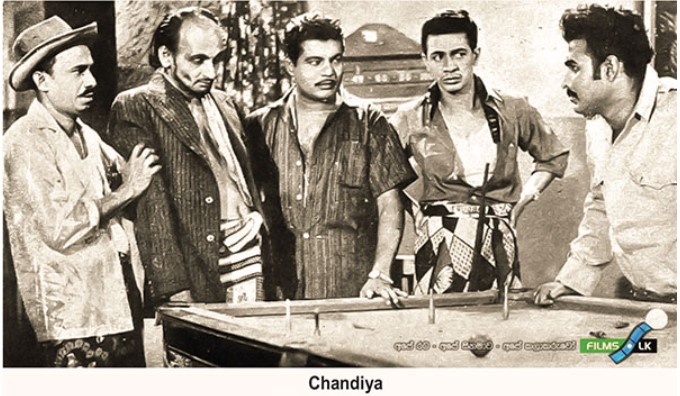 No less profound is Gamini Fonseka’s acting. He doesn’t just underplay his performance; he constrains it. Sometime after the wedding Nanda comes across Jinadasa discussing the sale of a piece of land with an agent. He raises his voice, but only barely; Nanda has to get closer to hear what he’s saying. In the scenes that follow, he rarely asserts himself: even when his wife and her sister engage in an argument about food, he watches on the side, refusing to take part. To see him here is to appreciate an actor immersing his character in introspective réflexion sur soi, and refusing to let his performance deteriorate into theatrics. In that sense he is Nanda’s mirror-image: a character lacking agency, initiative. By contrast, Nanda’s other love, Piyal, expresses himself more openly: towards the end, when in a burst of anger he lets out his jealous imaginings, he conjures for us a perfect contrast with Jinadasa.
No less profound is Gamini Fonseka’s acting. He doesn’t just underplay his performance; he constrains it. Sometime after the wedding Nanda comes across Jinadasa discussing the sale of a piece of land with an agent. He raises his voice, but only barely; Nanda has to get closer to hear what he’s saying. In the scenes that follow, he rarely asserts himself: even when his wife and her sister engage in an argument about food, he watches on the side, refusing to take part. To see him here is to appreciate an actor immersing his character in introspective réflexion sur soi, and refusing to let his performance deteriorate into theatrics. In that sense he is Nanda’s mirror-image: a character lacking agency, initiative. By contrast, Nanda’s other love, Piyal, expresses himself more openly: towards the end, when in a burst of anger he lets out his jealous imaginings, he conjures for us a perfect contrast with Jinadasa.
It’s hard to imagine Gamini Fonseka playing Jinadasa. Indeed, in 1963, when Gamperaliya was released, few thought otherwise. Martin Wickramasinghe complained to Lester James Peries that he had essentially mauled Jinadasa’s character by handing it over to a man more suited to playing a boxer. It’s a sign of Wickramasinghe’s humility that he later admitted to Lester that he’d been mistaken, but his misgivings were not unjustified: to consider Gamini, even by then the established A-star of the Sinhala cinema, for a performance that called for introspection over action, was a challenge. Yet as events thereafter confirmed well, while he fit the mould of the action star, the fighter who asked for, expected, and gave no quarter, he could just as easily fit into other moulds and other characters.
Pauline Kael once called Marlon Brando the quintessential American hero: a man trying to be a contender and a somebody, yet tragically cut down by his circumstances to be the bum he played in role after role. Insofar as Brando symbolised this sort of tragic heroism, he was probably more comparable to Tony Ranasinghe than to Gamini. But Brando’s swagger, self-confidence, and deliberate carelessness shared more with Gamini.
Whenever you saw Gamini, you always felt he wanted to give out something more than what he had in him. For him to work with another star was thus inconceivable; to dominate the world he was in, he had to be at the centre of it all.
On the other hand, whenever he was cast in a secondary role, he prevailed over every other player. This happened most forcefully in Sandesaya: despite being slotted in next to Ananda Jayaratne, he dominates the story. In Gamperaliya, a relatively austere work, he wouldn’t have had much room to dominate over the rest of the cast. But as subsequent films were to show, you could only act alongside him by playing second fiddle. Thus even in a commercial outing like Chandi Shyama, the story moves in a different direction when he appears. More than a decade later, when he emerges as the heroine’s older lover in the second half of Loku Duwa, he diverts the plot from what it had been leading to in the first.
All that, of course, underscored his tremendous appeal. Here it’s important to place him in his proper context. Gamini Fonseka became the hero of the Sinhala screen at a time when audiences were beginning to move away from the theatrical flicks they had got used to in the immediate post-independence era. Heavily influenced by the Tower Hall tradition, the acting in these films differed very little from the revues of the Parsi stage.
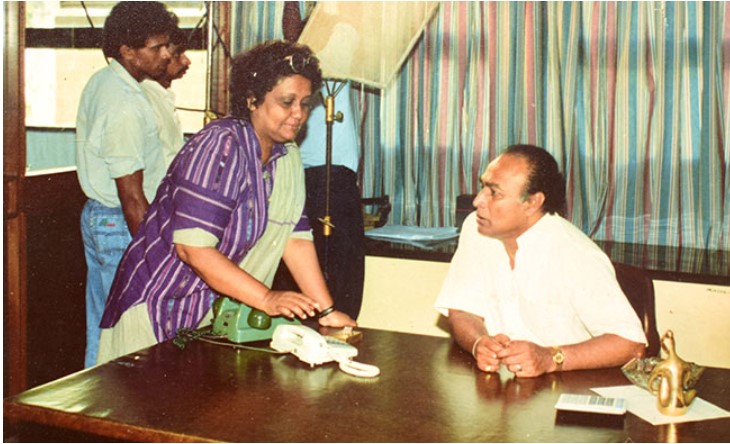
That these actors played onstage and onscreen merely emphasised the theatricality of both the performances and the stories in these films: a cultural anomaly reversed by Lester James Peries’s Rekava in 1956. Gamini’s appearance at this juncture, firstly as an assistant aboard The Bridge on the River Kwai and then in a small role in Daiwa Yogaya, was not coincidental: this was a new era for the Sinhala film, and it called for a new acting pedigree.
Gamini brought with him a new moral code for movie heroes. Blending into his characters like none of his predecessors had or could, he brought out a new realism that audiences had not seen until then. When you see him pick fights with the villain in Chandiya, a landmark for its time because it did not hesitate to depict its protagonist’s moral ambivalence, you no longer see the conventional hero local audiences had grown used to.
These protagonists operated in a world where the corrupt were those supposed to uphold the law and the few good men were those ostracised as outlaws. Gamini’s sense of justice went beyond the limits of the law. Whether he was pushed to it or whether he put himself into the thick of it, his concern was for the underdog.
The earliest fight scenes in Sinhala films contain an artificiality that, when viewed today, takes away from the delights of such altercations. Static and lifeless, they are invariably shot from one angle and limited to one frame. The music, rising to a jarring crescendo, only adds to the maudlin sentimentality underlying it all. Gamini did away with these conventions and breathed new life into the fight scene, turning it into a veritable art.
All that merely revealed the man’s immense vitality and versatility. Spreading far and wide, his interests went well beyond the cinema. He was profoundly concerned with politics and matters of social justice: themes which crop up in Sarungale, a work that, for all intents and purposes, might as well have been co-directed by him. We have it from D. B. S. Jeyaraj that just before Sarungale’s release, Gamini declared that no Sinhala man would lay his hands on a Tamil person again after seeing it. 1983 showed how wrong he was, but the point was that he shared a concern for the country he was born to. To say that is perhaps not to accept his politics, which Regi Siriwardena made a snide reference to in his review of Sarungale, but to reject his politics is not to dismiss his concerns altogether.
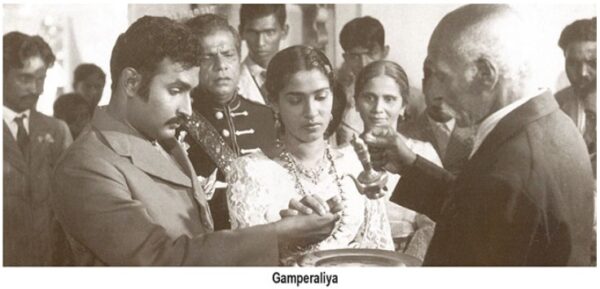 Gamini also displayed an interest in poetry and sketching, pursuits which have, barring the occasional biography, not been properly delved into by journalists. Widely read and deeply immersed in the mechanics of his art, he is an example to those who think you can become an actor by the force of your physique alone. Indeed, anyone who has seen his performance in Nidhanaya will confirm the point that it takes intelligence, hard work, luck, and more than any of these, practice, to unearth your acting skills.
Gamini also displayed an interest in poetry and sketching, pursuits which have, barring the occasional biography, not been properly delved into by journalists. Widely read and deeply immersed in the mechanics of his art, he is an example to those who think you can become an actor by the force of your physique alone. Indeed, anyone who has seen his performance in Nidhanaya will confirm the point that it takes intelligence, hard work, luck, and more than any of these, practice, to unearth your acting skills.
How far this point will apply in a society where acting has all but completely been detached from its intellectual heritage is, of course, a question I am ill-fitted to answer. Yet seeing the many trends pounding the industry today, I remain sceptical: as with other fields of activity, we have dumbed down the art of acting, deplorably.
Straddling the worlds of both art-house and commercial films, Gamini Fonseka went on to dominate the Sinhala cinema. There is a scene in Welikathara where he converses with the villain, Goring Mudalali, at his office. Tissa Abeysekara’s dialogues spice up the altercation, with one salty witticism following another. The words hold back the tension: what you see are two dogs only a hair’s breadth away from pouncing at each other.
Watching Gamini talk the way he does, you are reminded of a similar encounter from a film made a quarter century later: Michael Mann’s Heat, which also pits a police officer against a powerful thief. There, too, the faceoff unfolds as a conversation, this time at a diner. There, too, the politeness of the conversation belies a sense of revulsion. Yet it is a sad testament to how far back we have gone that while Heat epitomises acting of the sort that Hollywood has standardised, Welikathara epitomises what we once held as a standard, but is no longer a yardstick. This is, of course, regrettable. But it is no less reversible.
The writer can be reached at udakdev1@gmail.com







